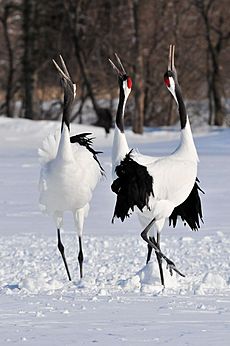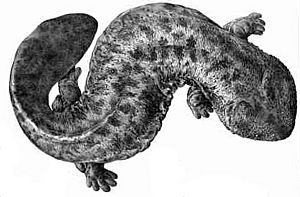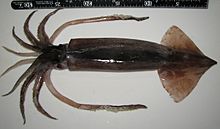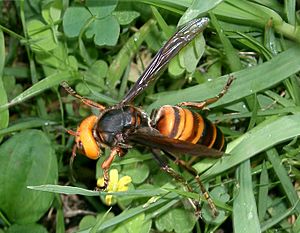Wildlife of Japan facts for kids
The wildlife of Japan includes all its plants (flora), animals (fauna), and their natural homes (habitats). Japan's islands stretch far from north to south, covering many different climate zones. This creates a huge variety of wildlife, even though Japan is separated from mainland Asia.
In the north, you'll find animals and plants that like cold, subarctic weather. These species often came from northern areas. In the south, you'll see species typical of tropical regions, similar to those in Southeast Asia. In between, there's a temperate zone with many species also found in China and Korea. Japan also has many unique species found nowhere else, including some rare or endangered ones.
Contents
Amazing Animals of Japan
Mammals: Furry Friends
About 130 types of land mammals live in Japan. The biggest are the two kinds of bears. The Ussuri brown bear lives in Hokkaidō. It's very important to the culture of the Ainu people. The Asian black bear lives in the mountains of Honshū, Kyūshū, and Shikoku.
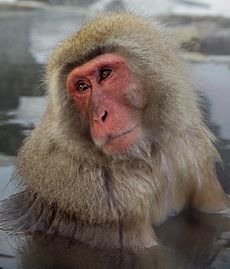
Smaller meat-eating mammals include the red fox, raccoon dog, and Japanese marten. Japan has two wild cats. The leopard cat from mainland Asia lives on Tsushima Island. The Iriomote cat is special because it's only found on Iriomote Island.
Plant-eating mammals include the sika deer, Japanese serow, and wild boar. One of Japan's most famous mammals is the Japanese macaque. These "snow monkeys" are the world's most northern monkeys!
In the ocean around Japan, you can find marine mammals like the dugong, finless porpoise, and Steller sea lion.
Birds: Feathered Wonders
Over 600 types of birds have been seen in Japan. More than 250 of these birds make Japan their home for breeding. Some birds are found only in Japan. These include the Japanese woodpecker, copper pheasant, and Japan's national bird, the green pheasant.
Some birds are unique to Japan's smaller islands. Examples are the Okinawa rail, Izu thrush, and Bonin white-eye. Most birds not unique to Japan are also found in China. A few come from Siberia or Southeast Asia.
Many migrant birds fly through Japan in spring and autumn. These include many wading birds. In winter, several places in Japan are important homes for swans, geese, and cranes.
Reptiles and Amphibians: Scaly and Slimy Creatures
Japan has about 73 types of reptiles. Nearly half of them are found only in Japan. Sea turtles and very venomous but shy sea snakes live in the warmer waters of southern Japan. This includes the black-banded sea krait.
Venomous land snakes include the mildly venomous tiger keelback. More venomous snakes are the elegant pit viper, Okinawa habu, Tokara habu, hime habu, and the mamushi. Many pit viper species, called "habus," are unique to the warm Ryukyu Islands. However, the mamushi is found on Japan's main islands.
Non-venomous rat snakes in Japan include the Japanese rat snake, Japanese forest rat snake, and Japanese four-lined rat snake. The king rat snake and beauty rat snake are found only in the warm Ryukyu Islands.
Lizards in Japan include many unique skink species, especially on the southern islands. The viviparous lizard lives as far north as Hokkaido. The Okinawa tree lizard is another example. Freshwater turtles include the unique Japanese pond turtle and Ryukyu black-breasted leaf turtle.
Japan has over 40 types of amphibians. One is the Japanese giant salamander, which is one of the world's largest amphibians! The Asiatic salamander family is very common here. Many of its members are found only in Japan.
Fish: Life in Water
Over 3000 different types of fish have been found in Japan. Important freshwater fish include the ayu, crucian carp, and common carp. The common carp is the ancestor of the famous domestic koi carp.
Small freshwater fish include the pale chub, Japanese chub, and several types of bitterling. This includes the endangered rosy bitterling. The southern Ryukyu Islands have unique, colorful freshwater gobies.
Some fish, called anadromous fish, live in both fresh and salt water. Six types of salmon are found in Japan: chinook salmon, chum salmon, pink salmon, coho salmon, sockeye salmon, and cherry salmon. The Japanese taimen is the largest fish to enter freshwater in Japan. It can grow up to 2 meters long! This fish is critically endangered.
Important saltwater fish include the red sea bream. Mudskippers live in warmer areas. Coral reefs in the Ryukyu Islands are home to many tropical fish like parrotfish and anemonefish. Rare deep-sea sharks like the goblin shark and frilled shark have been seen off Japan.
The Japanese flying squid lays its eggs in winter. The young squid grow in the East China Sea. Adult squid then travel with ocean currents to rich feeding grounds near northern Honshu and Hokkaido.
Insects: Tiny but Mighty
Japan has about 300 kinds of butterflies. This includes several tropical milkweed butterflies in the Ryūkyū Islands. There are around 190 types of dragonflies, including the ancient Epiophlebia superstes.
Other well-known insects in Japan include cicadas, crickets, the Asian giant hornet, and fireflies. Watching fireflies glow is a popular tourist activity in some areas.
Some butterflies are endangered and are on Japan's Red List. For example, Niphanda fusca is a parasitic butterfly. It used to live in traditional Japanese landscapes called satoyama. But due to changes in these areas, this butterfly has become endangered.
Amazing Plants of Japan
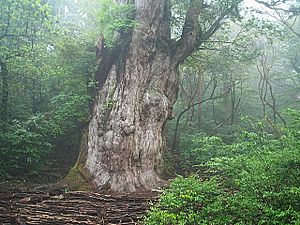
Between 4000 and 6000 types of plants grow naturally in Japan. The plants vary greatly from south to north. In the subtropical south, you can find mangroves, cycads, and tree ferns.
In the warm-temperate climate of Kyūshū, Shikoku, and southwestern Honshū, you'll see forests of broad-leaved evergreen trees, including many oaks. In northern Honshū and southwestern Hokkaidō, the climate is cooler. Here, broad-leaved deciduous trees like Japanese beech and jolcham oak are common.
Conifers are the main trees in much of Hokkaidō and in the mountains of central and northern Honshū. You'll find spruces and firs growing there. In the highest mountains, there are Arctic–alpine plants. These include the low-growing Siberian dwarf pine.
Many natural forests have been replaced by conifer plantations. Common trees grown include the hinoki cypress, Japanese red pine, Japanese black pine, and sakaki evergreen. The Japanese red cedar is Japan's tallest conifer, reaching 40 meters high.
Bamboo grows everywhere in Japan. There are about 400 to 500 different types. These include small dwarf bamboos called sasa and taller kinds called take, which can grow up to 20 meters tall.
Many plants were brought to Japan from mainland Asia. These include important crops like rice and garden plants like the chrysanthemum. More plants have come from Europe and North America since the Meiji Restoration. Native Japanese food plants include the water dropwort and wasabi.
See also
 In Spanish: Biota silvestre de Japón para niños
In Spanish: Biota silvestre de Japón para niños


